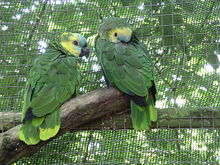Amazon parrot
2008/9 Schools Wikipedia Selection. Related subjects: Birds
| Amazon parrots | ||||||||||||||||
|---|---|---|---|---|---|---|---|---|---|---|---|---|---|---|---|---|
 Blue-fronted Amazon (Amazona aestiva)
|
||||||||||||||||
| Scientific classification | ||||||||||||||||
|
||||||||||||||||
| Species | ||||||||||||||||
|
Many, see text. |
An Amazon parrot is a large parrot of the genus Amazona native to the New World ranging from South America to Mexico and the Caribbean.
Most Amazons are predominantly green, with accenting colors that depend on the species and can be quite vivid. Amazons, like all parrots, are zygodactyl, having four toes on each foot—two front and two back. They feed primarily on nuts and fruits, supplemented by leafy matter.
Several amazon species are commonly kept as pets, including the Yellow-headed Amazon, Yellow-naped Amazon, and Blue-fronted Amazon.
Amazons are known for their exceptional vocal abilities, playfulness, and dexterity with their feet. They are very loyal, loving companions; having them is somewhat like having a two-year-old human child in ability and temperament for 50-plus years. However, some Amazons are aggressive (usually during their mating time), and they all require a lot of attention when kept as pets. Parrots require more attention and care than domesticated pets such as dogs or cats. Parrots are highly intelligent wild animals. While there are a number of species of birds that can be kept as cage-bird pets with little human attention, parrots must have daily attention in order to keep them mentally healthy. Parrots are not for the inexperienced bird owner. All parrots need a lot of stimulating activities to keep from being bored and terribly destructive to themselves and their surroundings. In particular, since Amazons are cavity nesters in the wild, their desire to chew wood is strong, and they need to be provided with destructible toys to satisfy this innate urge.
Classification
- Cuban Amazon or Rose-throated Parrot, Amazona leucocephala
- Yellow-billed Amazon, Amazona collaria
- Hispaniolan Amazon, Amazona ventralis
- Puerto Rican Amazon, Amazona vittata
- Yellow-lored Amazon, Amazona xantholora
- White-fronted Amazon, Amazona albifrons
- Black-billed Amazon, Amazona agilis
- Tucumán Amazon, Amazona tucumana
- Red-spectacled Amazon, Amazona pretrei
- Red-crowned Amazon, Amazona viridigenalis
- Lilac-crowned Amazon, Amazona finschi
- Red-lored Amazon, Amazona autumnalis
- Blue-cheeked Amazon, Amazona dufresniana
- Red-browed Amazon, Amazona rhodocorytha
- Red-tailed Amazon, Amazona brasiliensis
- Festive Amazon, Amazona festiva
- Yellow-shouldered Amazon, Amazona barbadensis
- Blue-fronted Amazon, Amazona aestiva
- Yellow-crowned Amazon, Amazona ochrocephala
- Yellow-naped Amazon, Amazona (ochrocephala) auropalliata
- Yellow-headed Amazon, Amazona (ochrocephala) oratrix
- Kawall's Amazon, Amazona kawalli
- Orange-winged Amazon, Amazona amazonica
- Scaly-naped Amazon, Amazona mercenaria
- Mealy Amazon, Amazona farinosa
- Vinaceous Amazon, Amazona vinacea
- St Lucia Amazon, Amazona versicolor
- Red-necked Amazon, Amazona arausiaca
- St. Vincent Amazon, Amazona guildingii
- Imperial Amazon, Amazona imperialis
- Martinique Amazon, Amazona martinica (extinct)
- Guadeloupe Amazon, Amazona violacea (extinct)
Another species has traditionally been placed within this genus, but recent research has shown that it is closer to the Short-tailed Parrot and the species from the genus Pionus, resulting in it being transferred to the monotypic genus Alipiopsitta:
- Yellow-faced Parrot, Alipiopsitta xanthops
The taxonomy of the Yellow-crowned Amazon (Amazona ochrocephala complex) is disputed, with some authorities only listing a single species (A. ochrocephala), while others split it into as many as three species (A. ochrocephala, A. auropalliata and A. oratrix). The split is primarily based on differences in extend of yellow to the plumage and the colour of bill and legs. Phylogenetic analysis of mtDNA do not support the split.